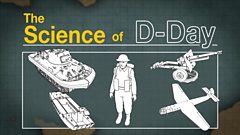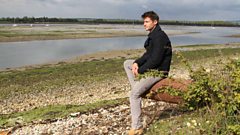The Science of D-Day
Engineer Rob Bell explores the new inventions - from giant troop-carrying gliders to tanks that could operate on water - that made the Normandy invasion in 1944 possible.
In June 1944, one of the greatest amphibious assaults in history was launched from the south coast of England. Within a matter of hours, 7,000 vessels had landed 156,000 troops on the beaches of Normandy. It was a manoeuvre that changed the course of the war and tested innovations in science and engineering for the first time.
In this programme, engineer Rob Bell looks at the nuts and bolts which made such a staggering invasion possible - from giant troop-carrying gliders to tanks that could drive on water - and how necessity really did become the mother of invention. Like all new inventions, not all of them worked and resulted in devastating consequences. We find out why. This is the science of D-Day.
Last on
Clips
-
![]()
Tank technology innovations
Duration: 04:13
-
![]()
Behind the Science of D-Day
Duration: 01:22
Music Played
-
![]()
Explosions in the Sky
Catastrophe and The Cure
-
![]()
Explosions in the Sky
First Breath After Coma
-
![]()
Jon Hopkins
Apparition
-
![]()
Jon Hopkins
Light Through The Veins (Glastonbury 2015)
D-Day fact file

- D-Day was the start of Operation Overlord, the Allied invasion of Nazi-occupied western Europe
- It took place on 6 June 1944
- 156,000 Allied troops landed along a 50-mile stretch of occupied France's coastline to fight Nazi Germany
- D-Day had been planned for more than a year, and those who were to take part spent several months training
- The ambitious air and sea assault was dependent on a combination of factors, including the weather, tidal conditions and surprise
- It was originally scheduled for 5 June
- Storms forced Supreme Allied Commander Gen Dwight Eisenhower to put it back 24 hours. Finally, the weather improved and he gave the command
- A total of 156,000 men took part in D-Day, but many times that number were to be involved in the ensuing campaign over the next few months
- A total of 6,000 ships and landing craft were involved, delivering troops to five beaches along a carefully selected stretch of the Normandy coast
Source: 大象传媒 News and 大象传媒 History
D-Day innovations

Seven thousand vessels landed 156,000 troops on the beaches of Normandy within a few hours as part of the D-Day landings.
听
Major Percy Hobart was the man behind many of these unconventional inventions known as 'Hobart's Funnies' including the Sherman Duplex Drive Tank and the flame-throwing Crocodile.
听
Credits
| Role | Contributor |
|---|---|
| Presenter | Rob Bell |
| Producer | Richard Townsend |
| Editor | Jane French |
Broadcasts
- Sat 7 Jun 2014 16:30大象传媒 One South & Oxfordshire only
- Sun 8 Jun 2014 12:30大象传媒 News UK & UK HD only
- Sun 8 Jun 2014 19:30
- Mon 9 Jun 2014 03:00
- Mon 19 Oct 2015 20:30
- Thu 8 Sep 2016 20:00
- Tue 19 Dec 2017 22:00
- Tue 2 Oct 2018 19:30
- Tue 4 Jun 2019 19:30
- Thu 6 Jun 2019 02:30
- Thu 3 Oct 2019 22:00
- Thu 6 Jun 2024 19:30
- Fri 7 Jun 2024 01:25
- Last Thursday 19:00
- Friday 01:50
Featured in...
![]()
75th Anniversary of D-Day
75th Anniversary of D-Day
![]()
Remembering D-Day
A collection of programmes commemorating the 75th anniversary of D-Day.
![]()
Commemorating VE Day 80
Commemorating VE Day 80
![]()
Commemorating D-Day at 80
Join us as we commemorate the 80th anniversary of the Normandy Landings on 6 June 1944.
![]()
iPlayer History Category :: Featured Episodes
iPlayer History category featured programmes






